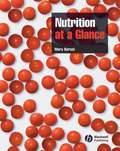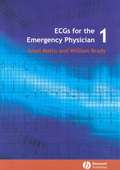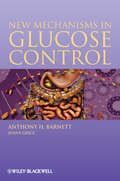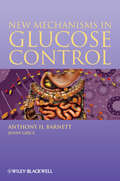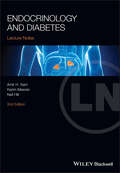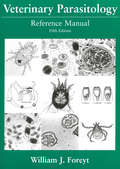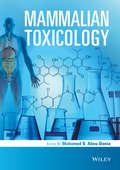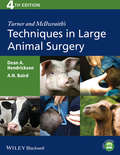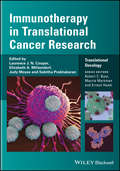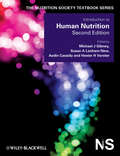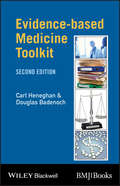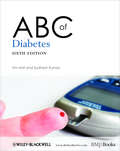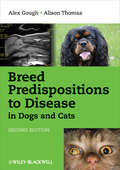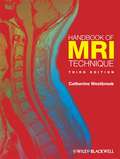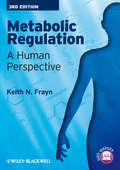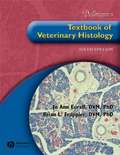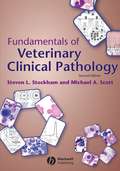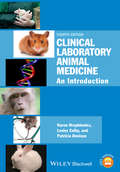- Table View
- List View
Nutrition at a Glance (At a Glance)
by Mary BarasiWith nutrition now recognised as a crucial part of the prevention and treatment of many human diseases and conditions, it is now more essential than ever that health studies, nursing and medical students have an understanding of the facts behind human nutrition. Nutrition at a Glance continues the popular series style of providing succinct information in a user-friendly, well illustrated format, with a broad coverage taking in such key topics as: • What makes an adequate diet • The role of key nutrients in maintaining heath • Food allergy and intolerance • Obesity, cancer, cardiovascular disease and gastrointestinal disease • Nutrition and the brain • Food choice and food policies An invaluable resource for students in need of an introduction to the area or a revision tool, this book will also serves as a handy quick reference for busy professionals needing to get to grips with this important subject.
ECGs for the Emergency Physician 1
by Amal MattuWith over 200 traces to test your knowledge, this book is a first class learning tool for emergency physicians. Basic student-level knowledge of ECGs is assumed, so the reader can move directly to learning about the more complex traces that occur in the emergency department. The level of difficulty is stratified into two sections for specialists in training and specialist emergency physicians. A minimum amount of information is given beneath each trace, as if in the real situation. The full clinical description is printed in a separate section to avoid the temptation of “looking”. Accompanied by learning points, and with the cases presented randomly, this book provides a rich source of information on the interpretation of ECGs – a core skill for all emergency department staff.
ECGs for the Emergency Physician 1
by Amal MattuWith over 200 traces to test your knowledge, this book is a first class learning tool for emergency physicians. Basic student-level knowledge of ECGs is assumed, so the reader can move directly to learning about the more complex traces that occur in the emergency department. The level of difficulty is stratified into two sections for specialists in training and specialist emergency physicians. A minimum amount of information is given beneath each trace, as if in the real situation. The full clinical description is printed in a separate section to avoid the temptation of “looking”. Accompanied by learning points, and with the cases presented randomly, this book provides a rich source of information on the interpretation of ECGs – a core skill for all emergency department staff.
New Mechanisms in Glucose Control
by Anthony H. Barnett Jenny GriceNew Mechanisms in Glucose Control presents a clear overview of the new drugs and treatment therapies that have been developed in recent years to help improve glycaemic management for the diabetic patient, namely the incretin mimetics (GLP-1 agonists) and DPP-4 inhibitors. It also considers other drug classes currently in development and undergoing clinical trials including the SGLT2 inhibitors and other pipeline products. In addition to pharma cotherapeutic agents, the role of bariatric as a management tool for diabetes is covered as well as consideration of the organisation of diabetes care with a community focus. This indispensable pocketbook details the newer treatments and offers a comparison with more traditional agents including sulphonyureas, glitazones and insulin. The pros and cons of traditional therapies are discussed as well as the epidemiology and pathogenesis of type 2 diabetes, helping to give the reader a better understanding of the disease area and its management. New Mechanisms in Glucose Control is essential reading for health professionals working in primary or secondary care and involved in treating diabetic patients.
New Mechanisms in Glucose Control
by Anthony H. Barnett Jenny GriceNew Mechanisms in Glucose Control presents a clear overview of the new drugs and treatment therapies that have been developed in recent years to help improve glycaemic management for the diabetic patient, namely the incretin mimetics (GLP-1 agonists) and DPP-4 inhibitors. It also considers other drug classes currently in development and undergoing clinical trials including the SGLT2 inhibitors and other pipeline products. In addition to pharma cotherapeutic agents, the role of bariatric as a management tool for diabetes is covered as well as consideration of the organisation of diabetes care with a community focus. This indispensable pocketbook details the newer treatments and offers a comparison with more traditional agents including sulphonyureas, glitazones and insulin. The pros and cons of traditional therapies are discussed as well as the epidemiology and pathogenesis of type 2 diabetes, helping to give the reader a better understanding of the disease area and its management. New Mechanisms in Glucose Control is essential reading for health professionals working in primary or secondary care and involved in treating diabetic patients.
Endocrinology and Diabetes (Lecture Notes)
by Amir H. Sam Karim Meeran Neil HillENDOCRINOLOGY AND DIABETES Lecture Notes 2nd Edition Balancing depth and accessibility, Endocrinology and Diabetes: Lecture Notes, 2nd Edition, provides medical students and junior doctors with the key information needed to understand mechanisms of endocrine conditions. This popular revision guide covers endocrine anatomy and physiology, scientific background, clinical presentations, diagnosis and management of various endocrine disorders. Clear and concise chapters focus on conditions commonly encountered in both clinical practice and assessments. Now in full colour, the second edition has been updated with further figures that demonstrate features of endocrine conditions. Features enhanced and expanded coverage of all major topics within diabetes and endocrinology Reflects the current knowledge base, evidence, and best practices in the field Provides easy access to the scientific background, presentation, diagnosis, and management of each condition Offers up-to-date information for those preparing for MRCP or endocrinology specialty exams Includes boxed sections in every chapter highlighting key points to aid revision and recall Endocrinology and Diabetes: Lecture Notes, 2nd Edition, remains a must-have for medical students, specialist nurses, junior doctors, and trainees working on endocrinology rotations or preparing for the Specialty Certificate Examination in Endocrinology. For more information on the complete range of Wiley medical student and junior doctor publishing, please visit: www.wiley.com To receive automatic updates on Wiley books and journals, join our email list. Sign up today at www.wiley.com/email This new edition is also available as an e-book. For more details, please see http://www.wiley.com/buy/9781118682241 All content reviewed by students for students Wiley Medical Education books are designed exactly for their intended audience. All of our books are developed in collaboration with students. This means that our books are always published with you, the student, in mind. If you would like to be one of our student reviewers, go to www.reviewmedicalbooks.com to find out more.
Endocrinology and Diabetes (Lecture Notes)
by Amir H. Sam Karim Meeran Neil HillENDOCRINOLOGY AND DIABETES Lecture Notes 2nd Edition Balancing depth and accessibility, Endocrinology and Diabetes: Lecture Notes, 2nd Edition, provides medical students and junior doctors with the key information needed to understand mechanisms of endocrine conditions. This popular revision guide covers endocrine anatomy and physiology, scientific background, clinical presentations, diagnosis and management of various endocrine disorders. Clear and concise chapters focus on conditions commonly encountered in both clinical practice and assessments. Now in full colour, the second edition has been updated with further figures that demonstrate features of endocrine conditions. Features enhanced and expanded coverage of all major topics within diabetes and endocrinology Reflects the current knowledge base, evidence, and best practices in the field Provides easy access to the scientific background, presentation, diagnosis, and management of each condition Offers up-to-date information for those preparing for MRCP or endocrinology specialty exams Includes boxed sections in every chapter highlighting key points to aid revision and recall Endocrinology and Diabetes: Lecture Notes, 2nd Edition, remains a must-have for medical students, specialist nurses, junior doctors, and trainees working on endocrinology rotations or preparing for the Specialty Certificate Examination in Endocrinology. For more information on the complete range of Wiley medical student and junior doctor publishing, please visit: www.wiley.com To receive automatic updates on Wiley books and journals, join our email list. Sign up today at www.wiley.com/email This new edition is also available as an e-book. For more details, please see http://www.wiley.com/buy/9781118682241 All content reviewed by students for students Wiley Medical Education books are designed exactly for their intended audience. All of our books are developed in collaboration with students. This means that our books are always published with you, the student, in mind. If you would like to be one of our student reviewers, go to www.reviewmedicalbooks.com to find out more.
Veterinary Parasitology Reference Manual
by William J. ForeytVeterinary Parasitology Reference Manual, Fifth Edition is a practical, thorough, bench top reference for basic diagnostic veterinary parasitology. The manual provides pertinent information on parasite life cyles, importance, location in the host, zoonotic potential, current literature, diagnosis, and treatment. It also includes step-by-step instructions for the most common diagnostic procedures used in routine veterinary practice. Sections are organized by animal host species, including dogs; cats; cattle, sheep and goats; llamas; horses; pigs; birds; ratites (ostriches, emus, and cassowaries); and laboratory animals, as well as wildlife, reptiles, marine mammals, and humans. There is a section in which common artifacts found in fecal samples are presented, and the last section includes conversion tables and a list of abbreviations. Features of the Fifth edition include: * updated and enhanced references * information on new drugs * improved section on parasites of marine mammals * sections on parasites of laboratory animals and humans * over 500 photographs and figures Readers will find this to be an easily accessible and accurate resource for information about parasites in a variety of animals - wild, domestic, common and exotic.
Veterinary Parasitology Reference Manual
by William J. ForeytVeterinary Parasitology Reference Manual, Fifth Edition is a practical, thorough, bench top reference for basic diagnostic veterinary parasitology. The manual provides pertinent information on parasite life cyles, importance, location in the host, zoonotic potential, current literature, diagnosis, and treatment. It also includes step-by-step instructions for the most common diagnostic procedures used in routine veterinary practice. Sections are organized by animal host species, including dogs; cats; cattle, sheep and goats; llamas; horses; pigs; birds; ratites (ostriches, emus, and cassowaries); and laboratory animals, as well as wildlife, reptiles, marine mammals, and humans. There is a section in which common artifacts found in fecal samples are presented, and the last section includes conversion tables and a list of abbreviations. Features of the Fifth edition include: * updated and enhanced references * information on new drugs * improved section on parasites of marine mammals * sections on parasites of laboratory animals and humans * over 500 photographs and figures Readers will find this to be an easily accessible and accurate resource for information about parasites in a variety of animals - wild, domestic, common and exotic.
Mammalian Toxicology
by Mohamed Abou-DoniaMammalian Toxicology surveys chemical agents and examines how such chemicals impact on human health, emphasizing the importance in minimizing environmental exposure to chemical and physical hazards in our homes, communities and workplaces through such media as contaminated water, soil and air. Starting with the basic principles on a wide range of toxic agents, this textbook describes how they enter the body, their mechanisms of action once inside, and strategies for diagnosis, prevention and treatment. Topics covered include: General principles of toxicology: pharmacological and toxicological principles underpinning the study of toxicology, risk assessments and mechanisms of cell death Disposition: routes of chemical exposures, entry into the body and various tissues, storage, metabolic biotransformation and elimination, with examples from various toxicants. Toxic agents: the occurrences, disposition in the body, health effects, toxic mechanisms, antidotes and treatments of a range of agents including pesticides, metals, solvents, gases, nanomaterials, food components and additives, pharmaceuticals, drugs of abuse, natural toxins, endocrine disruptors, radiation, and warfare weapons. Toxic effects: including neurotoxicity, developmental toxicity, immunotoxicity, teratogenecity, male and female reproductive toxicity, mutagenecity, carcinogenicity, pulmonary toxicity, cardiovascular toxicity, hepatotoxicity, gastrointestinal toxicity and cardiovascular toxicity Toxicology and society: epidemiological studies of chemical-induced diseases in human populations, and a vision for toxicology in the 21st century. Mammalian Toxicology is an essential primer for students of toxicology, biochemistry, biology, medicine and chemistry. It is also appropriate for professional toxicologists in research or regulatory affairs, and anyone who needs to understand the adverse effects of toxic agents on the human body.
Mammalian Toxicology
by Mohamed Abou-DoniaMammalian Toxicology surveys chemical agents and examines how such chemicals impact on human health, emphasizing the importance in minimizing environmental exposure to chemical and physical hazards in our homes, communities and workplaces through such media as contaminated water, soil and air. Starting with the basic principles on a wide range of toxic agents, this textbook describes how they enter the body, their mechanisms of action once inside, and strategies for diagnosis, prevention and treatment. Topics covered include: General principles of toxicology: pharmacological and toxicological principles underpinning the study of toxicology, risk assessments and mechanisms of cell death Disposition: routes of chemical exposures, entry into the body and various tissues, storage, metabolic biotransformation and elimination, with examples from various toxicants. Toxic agents: the occurrences, disposition in the body, health effects, toxic mechanisms, antidotes and treatments of a range of agents including pesticides, metals, solvents, gases, nanomaterials, food components and additives, pharmaceuticals, drugs of abuse, natural toxins, endocrine disruptors, radiation, and warfare weapons. Toxic effects: including neurotoxicity, developmental toxicity, immunotoxicity, teratogenecity, male and female reproductive toxicity, mutagenecity, carcinogenicity, pulmonary toxicity, cardiovascular toxicity, hepatotoxicity, gastrointestinal toxicity and cardiovascular toxicity Toxicology and society: epidemiological studies of chemical-induced diseases in human populations, and a vision for toxicology in the 21st century. Mammalian Toxicology is an essential primer for students of toxicology, biochemistry, biology, medicine and chemistry. It is also appropriate for professional toxicologists in research or regulatory affairs, and anyone who needs to understand the adverse effects of toxic agents on the human body.
Turner and McIlwraith's Techniques in Large Animal Surgery
by Dean A. Hendrickson A. N. BairdTurner and McIlwraith’s Techniques in Large Animal Surgery, Fourth Edition is an updated version of the classic resource for step-by-step instruction on basic surgical techniques in cattle, horses, swine, goats, and llamas. With detailed line drawings to demonstrate the principles discussed, the book addresses general aspects of surgery such as anesthesia and equipment and provides descriptions of surgical conditions and techniques commonly encountered in large animal practice. Now including a website with interactive review questions and the figures from the book in PowerPoint, the Fourth Edition is a highly practical, reliable guide for veterinary students and veterinary practitioners with a large animal caseload. The Fourth Edition includes eight new techniques and completely rewritten chapters on anesthesia, equine wound management, and surgical techniques in bovine and swine patients, as well as revisions to reflect advances throughout the book and updated references. Turner and McIlwraith’s Techniques in Large Animal Surgery continues to supply students and practitioners alike with a valuable resource on the fundamental techniques of farm animal surgery.
Turner and McIlwraith's Techniques in Large Animal Surgery
by Dean A. Hendrickson A. N. BairdTurner and McIlwraith’s Techniques in Large Animal Surgery, Fourth Edition is an updated version of the classic resource for step-by-step instruction on basic surgical techniques in cattle, horses, swine, goats, and llamas. With detailed line drawings to demonstrate the principles discussed, the book addresses general aspects of surgery such as anesthesia and equipment and provides descriptions of surgical conditions and techniques commonly encountered in large animal practice. Now including a website with interactive review questions and the figures from the book in PowerPoint, the Fourth Edition is a highly practical, reliable guide for veterinary students and veterinary practitioners with a large animal caseload. The Fourth Edition includes eight new techniques and completely rewritten chapters on anesthesia, equine wound management, and surgical techniques in bovine and swine patients, as well as revisions to reflect advances throughout the book and updated references. Turner and McIlwraith’s Techniques in Large Animal Surgery continues to supply students and practitioners alike with a valuable resource on the fundamental techniques of farm animal surgery.
Immunotherapy in Translational Cancer Research (Translational Oncology)
by Laurence J. N. Cooper Elizabeth A. Mittendorf Judy Moyes Sabitha PrabhakaranA guide to state-of-the-art cancer immunotherapy in translational cancer research A volume in the Translational Oncology series, Immunotherapy in Translational Cancer Research explores the recent developments in the role that immunotherapy plays in the treatment of a wide range of cancers. The editors present key concepts, illustrative examples, and suggest alternative strategies in order to achieve individualized targeted therapy. Comprehensive in scope, Immunotherapy in Translational Cancer Research reviews the relevant history, current state, and the future of burgeoning cancer-fighting therapies. The book also includes critical information on drug development, clinical trials, and governmental resources and regulatory issues. Each chapter is created to feature: development of the immunotherapy; challenges that have been overcome in order to scale up and undertake clinical trials; and clinical experience and application of research. This authoritative volume is edited by a team of noted experts from MD Anderson Cancer Center, the world’s foremost cancer research and care center and: Offers a comprehensive presentation of state-of-the-art cancer immunotherapy research that accelerates the pace of clinical cancer care Filled with the concepts, examples, and approaches for developing individualized therapy Explores the breath of treatments that reflect the complexity of the immune system itself Includes contributions from a panel international experts in the field of immunotherapy Designed for physicians, medical students, scientists, pharmaceutical executives, public health and public policy government leaders and community oncologists, this essential resource offers a guide to the bidirectional interaction between laboratory and clinic immunotherapy cancer research.
Immunotherapy in Translational Cancer Research (Translational Oncology)
by Laurence J. N. Cooper Elizabeth A. Mittendorf Judy Moyes Sabitha PrabhakaranA guide to state-of-the-art cancer immunotherapy in translational cancer research A volume in the Translational Oncology series, Immunotherapy in Translational Cancer Research explores the recent developments in the role that immunotherapy plays in the treatment of a wide range of cancers. The editors present key concepts, illustrative examples, and suggest alternative strategies in order to achieve individualized targeted therapy. Comprehensive in scope, Immunotherapy in Translational Cancer Research reviews the relevant history, current state, and the future of burgeoning cancer-fighting therapies. The book also includes critical information on drug development, clinical trials, and governmental resources and regulatory issues. Each chapter is created to feature: development of the immunotherapy; challenges that have been overcome in order to scale up and undertake clinical trials; and clinical experience and application of research. This authoritative volume is edited by a team of noted experts from MD Anderson Cancer Center, the world’s foremost cancer research and care center and: Offers a comprehensive presentation of state-of-the-art cancer immunotherapy research that accelerates the pace of clinical cancer care Filled with the concepts, examples, and approaches for developing individualized therapy Explores the breath of treatments that reflect the complexity of the immune system itself Includes contributions from a panel international experts in the field of immunotherapy Designed for physicians, medical students, scientists, pharmaceutical executives, public health and public policy government leaders and community oncologists, this essential resource offers a guide to the bidirectional interaction between laboratory and clinic immunotherapy cancer research.
Introduction to Human Nutrition (The Nutrition Society Textbook)
by Michael J Gibney Susan A Lanham-New Aedin Cassidy Hester H VorsterIn this Second Edition of the introductory text in the acclaimed Nutrition Society Textbook Series, Introduction to Human Nutrition has been revised and updated to meet the needs of the contemporary student. Groundbreaking in their scope and approach, the titles in the series: Provide students with the required scientific basics of nutrition in the context of a systems and health approach Enable teachers and students to explore the core principles of nutrition, to apply these throughout their training, and to foster critical thinking at all times. Throughout, key areas of knowledge are identified Are fully peer reviewed, to ensure completeness and clarity of content, as well as to ensure that each book takes a global perspective Introduction to Human Nutrition is an essential purchase for undergraduate and postgraduate students of nutrition/nutrition and dietetics degrees, and also for those students who major in other subjects that have a nutrition component, such as food science, medicine, pharmacy and nursing. Professionals in nutrition, dietetics, food science, medicine, health sciences and many related areas will also find much of great value within this book.
Evidence-Based Medicine Toolkit (EBMT-EBM Toolkit Series #12)
by Carl Heneghan Douglas BadenochThis bestselling pocket guide to the skills of evidence-based medicine succeeds in demystifying the terminology and processes in a handy and easy-to-follow format, all within the space of 100 pages. With an improved layout, this second edition of Evidence-based Medicine Toolkit offers more up-to-date guidance as well as new sections on important areas of research. New features of this second edition include: A box for each major database showing how to search the evidence, and highlighting the differences between them Flow charts for different study types New critical appraisal sections on qualitative research and economic evaluation Expanded list of EBM resources on the net. With these added features to make the job easier, the new Toolkit is now an even better companion for all health care professionals using evidence-based methodology in their research and practice.
ABC of Diabetes (ABC Series)
by Tim Holt Sudhesh KumarThe ABC of Diabetes provides a complete overview of diabetes including the aetiology, diagnosis and management of Types 1 and 2 diabetes, detection and prevention, and the organization of care and support. With new chapters on psychological aspects, surveillance for complications, and support for people living with diabetes, this completely revised edition covers the many changes taking place in diabetes care, particularly in screening for Type 2 diabetes; in monitoring and insulin administration; in the organisation and delivery of care; and the increasing prevalence of diabetes in both developed and developing countries. This sixth edition covers the early recognition of diabetes and cardiovascular risk as well as preventing complications specific to diabetes. It also addresses the need to deliver diabetes care in a multidisciplinary setting, including the UK Quality and Outcomes Framework, and reflects the increasing emphasis on self-management and patient-centred care, particularly as it relates to lifestyle changes, glycaemic control and patient choice over treatment options. Drawing on the expertise of the University of Warwick as a centre of excellence for the teaching of diabetes care, the best selling ABC of Diabetes is ideal for GPs, primary care practitioners, practice nurses, diabetes specialist nurses, health visitors and junior doctors.
Breed Predispositions to Disease in Dogs and Cats
by Alex Gough Alison ThomasThis unique resource brings together valuable information on breed-related diseases in one quick-reference volume. Divided into one section for dogs and another for cats, inherited and other prevalent disorders are listed breed-by-breed. The final section describes each of the disorders in more detail. All the information is drawn from high-quality sources, including research journals and veterinary texts, with extensive references provided. This invaluable reference helps veterinary professionals to advise clients on their choice of breed and what problems to look out for. Whether you're a veterinarian, geneticist, a breeder, or a pet owner, this fully-referenced book will save you hours of searching through scattered literature.
Handbook of MRI Technique
by Catherine WestbrookThe progress of magnetic resonance imaging (MRI) as a clinical tool has been extraordinary, out-stripping the rate of development of any other imaging technique. There has been a huge increase in the practical applications of MRI techniques and its uses look likely to extend even further with the development of high speed gradients and pulse sequences. The Handbook of MRI Technique has proved highly successful in guiding the uninitiated through scanning techniques and helping more experienced technologists to improve image quality. The third edition of this highly successful book has been fully revised and updated to consider new technologies and developments essential to good practice. The book is split into two parts. Part 1 considers the main aspects of theory that relate to scanning and also includes practical tips on gating, equipment use, patient care and safety, and information on contrast media. Part 2 provides step by step instruction for examining each anatomical area, beginning with a basic anatomy section, followed by sections on indications, patient positioning, equipment, artefacts and tips on optimizing image quality. A section of problem-solving exercises completes the book. Now in full color throughout with over 200 illustrations this book will continue to appeal to radiographers new to MRI and regular users who are looking for information on alternative techniques and suggestions on protocol modifications. Completely revised and updated Over 100 brand new photographs and line drawings Written by technologists for technologists With contributions from MRI technologists in the USA and Australia Suitable for users of all types of MRI systems
Metabolic Regulation: A Human Perspective (Frontiers In Metabolism/neurobiology Ser. #No. 1)
by Keith N. FraynThe important Third Edition of this successful book conveys a modern and integrated picture of metabolism and metabolic regulation. Explaining difficult concepts with unequalled clarity, author Keith Frayn provides the reader with an essential guide to the subject. Covering topics such as energy balance, body weight regulation and how the body copes with extreme situations, this book illustrates how metabolic regulation allows the human body to adapt to many different conditions. Changes throughout the new edition include: Extensive chapter updates Clear and accessible 2-color diagrams Q&A sections online at www.wiley.com/go/frayn to facilitate learning Frayn has written a book which will continue to be an extremely valuable tool for scientists, practitioners and students working and studying across a broad range of allied health sciences including medicine, biochemistry, nutrition, dietetics, sports science and nursing.
Dellmann's Textbook of Veterinary Histology
by Jo Ann Eurell Brian L. FrappierThe leading veterinary histology text returns with a fully updated sixth edition. Written in a concise, easy-to-understand that's a pleasure to read, this new edition continues the student-friendly tradition originated by Dr. Dellman, presenting the basics of histology including cytology and microscopic anatomy. The Sixth Edition focuses on the most current knowledge of cell, tissue and organ structure and function. All information has been fully revised and updated by the authors, both experts in their fields. Written with first year veterinary students in mind, it is also an important resource for veterinarians, graduate students, and others who require information on animal tissue structure and function. Highlights of the Sixth Edition include: New images and line drawings have been added to enhance the student's understanding of concepts. Two-page insert contains full-color histology images. Comprehensive listings of suggested readings at the end of each chapter encourage further study. The text is organized by body region, allowing the presentation to emphasize comparative species information so students can better appreciate how species differ in regard to key structures. Whether you're a veterinary student or practicing professional, you should have this classic histology reference as part of your working library.
Fundamentals of Veterinary Clinical Pathology
by Steven L. Stockham Michael A. ScottThis book provides in-depth information about common clinical laboratory assays that are used to evaluate domestic mammals, including what assays measure, sample or assay conditions that affect results, and what results indicate about the physiologic or pathologic state of a patient. Whenever possible, diseases and conditions are grouped by common mechanisms or processes to promote a conceptual understanding of laboratory data that can be generally applied across many species. New to the second edition are additional disorders, diagnostic tests, illustrations, images, references, and pathophysiologic explanations. This text has proven valuable to students and veterinarians wanting a fundamental understanding of veterinary clinical pathology.
Dellmann's Textbook of Veterinary Histology
by Jo Ann Eurell Brian L. FrappierThe leading veterinary histology text returns with a fully updated sixth edition. Written in a concise, easy-to-understand that's a pleasure to read, this new edition continues the student-friendly tradition originated by Dr. Dellman, presenting the basics of histology including cytology and microscopic anatomy. The Sixth Edition focuses on the most current knowledge of cell, tissue and organ structure and function. All information has been fully revised and updated by the authors, both experts in their fields. Written with first year veterinary students in mind, it is also an important resource for veterinarians, graduate students, and others who require information on animal tissue structure and function. Highlights of the Sixth Edition include: New images and line drawings have been added to enhance the student's understanding of concepts. Two-page insert contains full-color histology images. Comprehensive listings of suggested readings at the end of each chapter encourage further study. The text is organized by body region, allowing the presentation to emphasize comparative species information so students can better appreciate how species differ in regard to key structures. Whether you're a veterinary student or practicing professional, you should have this classic histology reference as part of your working library.
Clinical Laboratory Animal Medicine: An Introduction
by Karen Hrapkiewicz Lesley A. Colby Patricia DenisonClinical Laboratory Animal Medicine: An Introduction, Fourth Edition offers a user-friendly guide to the unique anatomy and physiology, care, common diseases, and treatment of small mammals and nonhuman primates. Carefully designed for ease of use, the book includes tip boxes, images, and review questions to aid in comprehension and learning. The Fourth Edition adds new information on transgenic mice, drug dosages, techniques, and environmental enrichment, making the book a comprehensive working manual for the care and maintenance of common laboratory animals. The book includes information on topics ranging from genetics and behavior to husbandry and techniques in mice, rats, gerbils, hamsters, guinea pigs, chinchillas, rabbits, ferrets, and nonhuman primates. A companion website provides editable review questions and answers, instructional PowerPoints, and additional images not found in the book. Clinical Laboratory Animal Medicine is an invaluable resource for practicing veterinarians, veterinary students, veterinary technicians, and research scientists.
